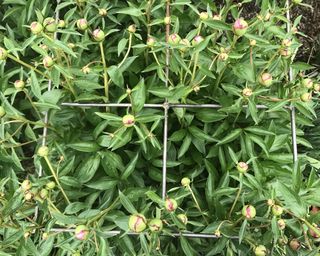How To Support Peonies: Keep Flowers From Falling Over

[ad_1]
Peonies are the most romantic blooms in the garden and make heavenly cut flowers. Unfortunately, these old-fashioned favorites are prone to falling over while the flowers are still in their prime.
This tends to happen after the rain, as the flower heads hold the water and their weak stems cannot take the extra weight. In addition, the plants’ rootballs need to be buried quite shallowly in the ground, meaning the flowers lack natural support for peonies.
Proper peony care will help to promote stronger stems, so ensure your plant is positioned in a sunny spot in rich, loamy, and well-draining soil. In spring, water deeply and fertilize peonies. However, certain types of peonies are simply more prone to falling over.
Unfortunately, it is the lovely blousy herbaceous peonies that are more susceptible. So if you don’t wish to add supports, then choose varieties bred to have stronger stems, such as Itoh peonies and hybrids.
How To Support Peonies
It is best to support peonies before they fall over, as they will never look quite as good again. You can do this by adding plant supports.
Ideally do this early in the spring, to allow the new growth to naturally fill in around the plant supports. However, take care not to pierce the crown with support legs or stakes, or you risk damaging the plant. Leave a gap around the plant edges of around three inches.
If your peonies have already begun to fall over, it is still best to intervene to get the best out of your flowers.
Choose from these support options and ensure your peony flowers make the impact they should.
1. Use A Peony Cage
(Image credit: Shutterstock)
Peony cages are designed to provide just the right amount of support for plants. The metal cages have three legs and two rings, with the top ring larger than the bottom, creating a fluted, funnel shape.
Available commonly in black, green, or rusted metal, the supports become almost invisible once the plant has properly grown in. However, ornamental designs can become attractive features in their own right.
As peony cages provide support in an upright circular form, they may not be the best option if you favor a softer, more natural look.
2. Make A Support With Canes And String

(Image credit: Shutterstock)
Bamboo canes tied with string make an easy and cost-effective way to support plants. It’s an ideal solution for peonies in a cut-flower garden, where you may have a large quantity of flowers that need staking.
While you can use dark green twine and rusted metal stakes to make the support more discreet, it is a less graceful solution than peony cages. However, it does allow for a bespoke solution that can be adjusted as needed and be made to any size.
To make a peony support with canes and string, simply insert canes into the soil around the perimeter of the plant and add two or three rows of string, tying a knot around each cane.
3. Stake Each Stem Individually

(Image credit: Alamy)
Supporting each individual flower stem with its own stake before the flowers bloom is a more time-consuming process. However, it responds to the natural growth habit of the peony, and may be preferable where flower heads are particularly large.
To support each stem, use slender canes or discreet metal stakes. Insert into the ground close to each stem, and use soft plant ties to secure each stem to its support. Try to cover the supports with the foliage as much as possible.
4. Add A Grow-Through Plant Grid

(Image credit: Getty Images)
Grow-through plant support grids are available in circular or rectangular designs, and provide holes for individual flowers to grow through.
They are initially more noticeable than other support methods, but once the flowers grow through they will be less obvious.
The main downside to plant support grids is that they are difficult to remove or reposition without damaging the flower heads that have grown through.
5. Make A Willow Support

(Image credit: Getty Images)
A willow support is the perfect option for a traditional country garden, as it adds to the aesthetic. While you can purchase willow supports, they can also be hand-made to the exact size you need.
To make a willow support, you will need bamboo canes, and young willow stems – these are usually soaked in water to make them more pliable.
Use hand pruners to trim lengths to size, and weave in and around the bamboo canes as desired. If necessary, use twine to tie the willow ends to the support.
[ad_2]
Source link






